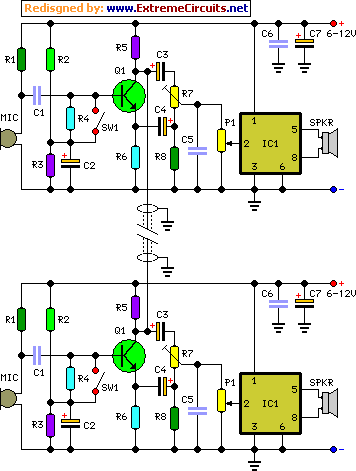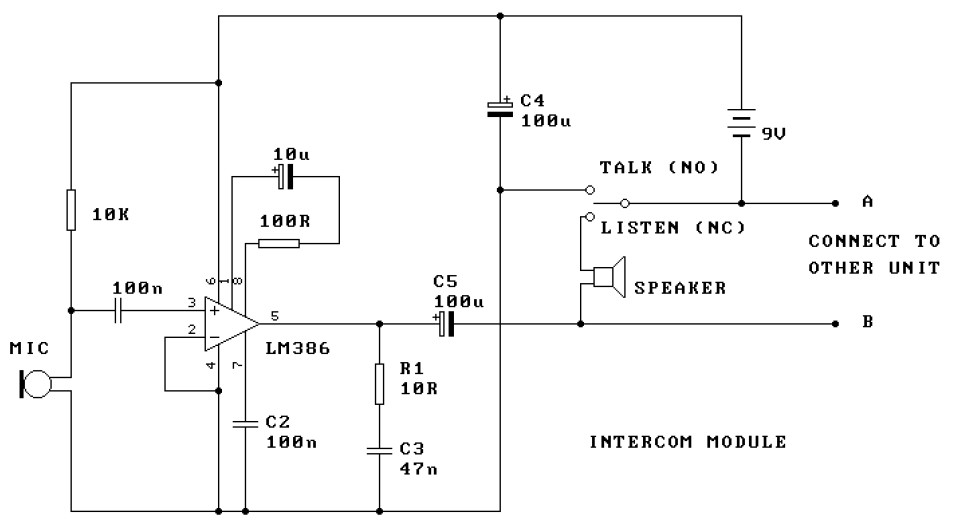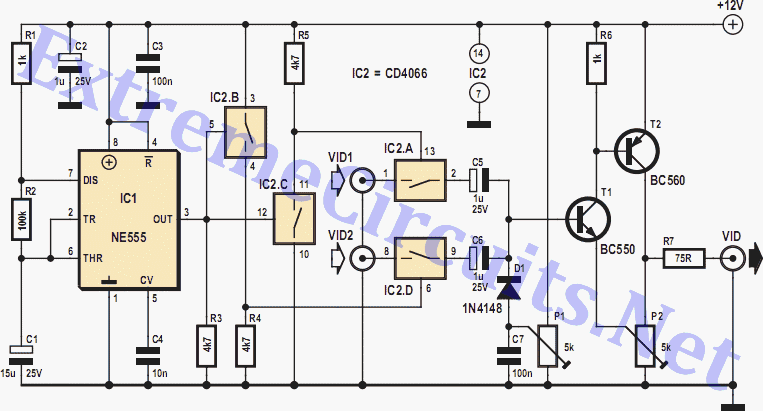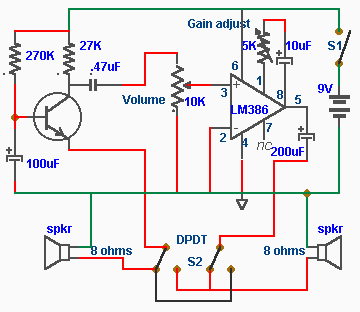
Full-duplex Intercom

This design enables the operation of two intercom stations, allowing the operator to remain hands-free for other tasks, thus eliminating the typical push-to-talk operation mode. No complex changeover switching is necessary; the two units are interconnected using a thin screened cable. Both microphones and loudspeakers are continuously operational, and a specialized circuit is implemented to prevent the loudspeaker output from being picked up by the microphone within the same unit, which would create an undesirable loud feedback known as the Larsen effect. A private switch is included to mute the microphone if needed. The circuit utilizes the TDA7052 audio power amplifier IC, which can deliver approximately 1 Watt of output power with a supply voltage in the range of 6 to 12V. A distinctive feature of this design is the microphone amplifier Q1: its audio output is phase-shifted by 180 degrees, with the output taken from the Collector and the in-phase output taken from the Emitter. These outputs are mixed through a network consisting of capacitors C3, C4 and resistors R7 and R8, with R7 being adjusted until the two incoming signals nearly cancel each other out. Consequently, the loudspeaker reproduces a very faint version of the signals captured by the microphone. Simultaneously, since the Collectors of both intercom units are connected, the 180-degree phase-shifted signal will pass to the audio amplifier of the second unit without any attenuation, allowing it to be amplified and loudly reproduced by its loudspeaker. The same process occurs when speaking into the microphone of the second unit; if R7 is properly adjusted, minimal output will be heard from its loudspeaker, while a loud and clear reproduction will be heard from the output of the first unit.
The intercom design incorporates a robust audio management system to facilitate seamless communication between two stations. The use of a thin screened cable for connection minimizes interference and enhances audio quality. The TDA7052 audio power amplifier IC is selected for its efficiency and capability to operate within a low voltage range, making it suitable for portable or battery-operated applications.
The microphone amplifier configuration utilizes a unique phase-shifting technique that is critical in preventing feedback loops. The careful adjustment of R7 ensures that the interaction between the outputs from the Collector and Emitter of Q1 is optimized for signal cancellation, effectively reducing the chances of feedback without compromising audio clarity. The capacitors C3 and C4 serve to filter and stabilize the mixed signals, ensuring that only the desired audio frequencies are amplified.
Additionally, the private switch adds a layer of functionality by allowing the operator to mute the microphone, which is particularly useful in scenarios where discretion is required. This feature enhances the versatility of the intercom system, making it suitable for a variety of applications, from security monitoring to industrial communication.
The overall design is compact and efficient, making it an ideal solution for environments where hands-free communication is essential. The intercom system's ability to minimize feedback while maintaining clear audio output exemplifies advanced engineering principles in audio circuit design.This design allows to operate two intercom stations leaving the operator free of using his/her hands in some other occupation, thus avoiding the usual push-to-talk operation mode. No complex changeover switching is required: the two units are connected together by means of a thin screened cable.
As both microphones and loudspeakers are always i n operation, a special circuit is used to avoid that the loudspeaker output can be picked-up by the microphone enclosed in the same box, causing a very undesirable and loud howl , i. e. the well known Larsen effect . A Private switch allows microphone muting, if required. The circuit uses the TDA7052 audio power amplifier IC, capable of delivering about 1 Watt of output power at a supply voltage comprised in the 6 12V range.
The unusual feature of this design is the microphone amplifier Q1: its 180 ° phase-shifted audio output taken at the Collector and its in-phase output taken at the Emitter are mixed by the C3, C4, R7 and R8 network and R7 is trimmed until the two incoming signals almost cancel out. In this way, the loudspeaker will reproduce a very faint copy of the signals picked-up by the microphone.
At the same time, as both Collectors of the two intercom units are tied together, the 180 ° phase-shifted signal will pass to the audio amplifier of the second unit without attenuation, so it will be loudly reproduced by its loudspeaker. The same operation will occur when speaking into the microphone of the second unit: if R7 will be correctly set, almost no output will be heard from its loudspeaker but a loud and clear reproduction will be heard at the first unit output.
🔗 External reference
The intercom design incorporates a robust audio management system to facilitate seamless communication between two stations. The use of a thin screened cable for connection minimizes interference and enhances audio quality. The TDA7052 audio power amplifier IC is selected for its efficiency and capability to operate within a low voltage range, making it suitable for portable or battery-operated applications.
The microphone amplifier configuration utilizes a unique phase-shifting technique that is critical in preventing feedback loops. The careful adjustment of R7 ensures that the interaction between the outputs from the Collector and Emitter of Q1 is optimized for signal cancellation, effectively reducing the chances of feedback without compromising audio clarity. The capacitors C3 and C4 serve to filter and stabilize the mixed signals, ensuring that only the desired audio frequencies are amplified.
Additionally, the private switch adds a layer of functionality by allowing the operator to mute the microphone, which is particularly useful in scenarios where discretion is required. This feature enhances the versatility of the intercom system, making it suitable for a variety of applications, from security monitoring to industrial communication.
The overall design is compact and efficient, making it an ideal solution for environments where hands-free communication is essential. The intercom system's ability to minimize feedback while maintaining clear audio output exemplifies advanced engineering principles in audio circuit design.This design allows to operate two intercom stations leaving the operator free of using his/her hands in some other occupation, thus avoiding the usual push-to-talk operation mode. No complex changeover switching is required: the two units are connected together by means of a thin screened cable.
As both microphones and loudspeakers are always i n operation, a special circuit is used to avoid that the loudspeaker output can be picked-up by the microphone enclosed in the same box, causing a very undesirable and loud howl , i. e. the well known Larsen effect . A Private switch allows microphone muting, if required. The circuit uses the TDA7052 audio power amplifier IC, capable of delivering about 1 Watt of output power at a supply voltage comprised in the 6 12V range.
The unusual feature of this design is the microphone amplifier Q1: its 180 ° phase-shifted audio output taken at the Collector and its in-phase output taken at the Emitter are mixed by the C3, C4, R7 and R8 network and R7 is trimmed until the two incoming signals almost cancel out. In this way, the loudspeaker will reproduce a very faint copy of the signals picked-up by the microphone.
At the same time, as both Collectors of the two intercom units are tied together, the 180 ° phase-shifted signal will pass to the audio amplifier of the second unit without attenuation, so it will be loudly reproduced by its loudspeaker. The same operation will occur when speaking into the microphone of the second unit: if R7 will be correctly set, almost no output will be heard from its loudspeaker but a loud and clear reproduction will be heard at the first unit output.
🔗 External reference





